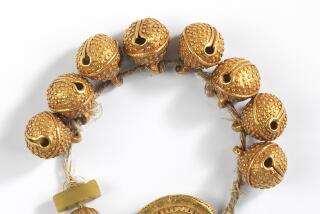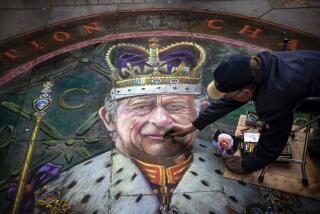Scots Get Back a Legendary Bit o’ Rock
- Share via
LONDON — Ever since King Edward I stole the Stone of Scone from Scotland and put it on display in Westminster Abbey 700 years ago, the chunk of sandstone has been a 336-pound reminder of the long history of distrust and suspicion between Scotland and England.
But Friday, the pale yellow stone--on which every great king of Scotland was crowned until 1296--was returned home to the skirl of pipes, toasts of whiskey and a school holiday. Though an hour behind schedule because of a bomb scare, the most controversial lump of stone in the not terribly United Kingdom was driven across the River Tweed in the back of an army jeep and ceremoniously returned to the Scottish nation.
Local notables toasted the homecoming liberally with wee drams of the national drink.
“Thank God it’s back where it belongs,” said Andrew McGregor, an office worker in the capital, Edinburgh.
Amid the celebrators, of course, were the naysayers, who spied, behind the liberation of the stone, just another cynical English scheme.
“This is not a matter for rejoicing. It looks like an event contrived by government to influence opinion in Scotland,” said Innes MacLeod, a historian at Glasgow University.
The return of the stone was either:
* A. A matter of historic justice
* B. A cheap political ploy
* C. A coup for Scottish tourism
* D. All of the above
Escorted across Coldstream Ford into Scotland by the Coldstream Guards, the stone was piped home by soldiers of the King’s Own Scottish Borderers. Their bagpipes played a jubilant new tune: “The Return of the Stone.”
“A very special moment for all Scots,” boasted Scottish Secretary of State Michael Forsyth.
John Swinton, the Lord Lieutenant of Berwickshire, observed: “The stone which was pinched by Edward I is now back. It’s very appropriate that it should come back here where Edward took it over the ford.”
*
That is the official story. But there are other views, and that is only fitting, for not even the history of the stone is without dispute.
Supposedly, the biblical prophet Jacob used it as a pillow when he dreamed of angels--except that it is almost certainly Scottish sandstone. From the Holy Land, legend says, the stone was reverently carried through Egypt, Sicily and Spain, reaching Ireland around 700 BC. There it rested on the hills of Tara, where ancient Irish kings were crowned.
Celtic invaders carried it off around AD 840, it is said, to a monastery in Scone where it was lugged up a hill as the coronation seat for Scottish kings. Including Macbeth, if he ever existed.
Since it was spirited south--despite fierce opposition to English rule from nationalists like William Wallace, a.k.a. Braveheart--the stone has lived in London.
At Westminster Abbey, it rested for centuries under the Coronation Chair, where the monarchs of England and Scotland are crowned, most recently Queen Elizabeth II.
The stone, whose identifying mark is two iron rings (so it can be carried suspended from a pole) will go back to London temporarily for the coronations of future British monarchs.
“There’s always been a sort of nagging feeling, an irritant, that the stone is part of our heritage and didn’t belong in Westminster,” said Janice McFarlane at the National Library in Edinburgh.
In 1950, four Scottish nationalists heisted the stone from the church, giving birth to a ballad whose lyrics McFarlane still recalls: “If you find the stone with the ring, just sit yourself down and declare yourself king. For there’s nobody here who can challenge your claim that you’ve crowned yourself king on the destiny stane [stone].”
(Scone is pronounced as is in “scoone[r] or later.”)
In 1951, no hard feelings, the stone went back to Westminster Abbey. Ian Hamilton, one of the firebrands who took it on Christmas Eve 46 years ago, is now a prominent lawyer in Edinburgh. He skipped Friday’s hoopla.
“He’s fed up with the whole thing and is not answering questions about it,” said his law clerk, Barney McKinnon.
About 1,000 people cheered the stone home at Coldstream, although no one actually saw it inside its steel box in the back of the jeep. Local Scottish kids had the day off, but, for English children on the other side of the border, it was lessons as usual.
“The stone is a symbol of Scotland’s past, which will now mark a new era in Scotland’s future,” said George Robertson, speaking for the opposition Labor Party.
*
Perhaps. But Scottish skeptics note that there was no popular demand for the stone’s return, not even after the recent spate of Scottish nationalist movies. The stone came home because the British government of Prime Minister John Major decided that it should, and it will go to Edinburgh Castle for display ($9 entry) because that is where the government wants it.
A recent poll of Scots, in fact, favored putting the contentious stone back at Scone, said Andrew R. Robinson, administrator of Scone Castle.
“Edinburgh has no claim whatsoever, legally, morally or whatever, to the Stone of Scone. It’s not called the Stone of Edinburgh, is it?” he asked Friday. Edinburgh didn’t even exist when the stone first came to Scone, Robinson says.
Like others who question the hurried return, Robinson detects politics at its core.
“After 700 years, why was there such a panic to bring it back?” he asked. Could it be that recent polls give the ruling Conservative Party, facing elections next spring, 11% of Scottish voters?
More to Read
Sign up for Essential California
The most important California stories and recommendations in your inbox every morning.
You may occasionally receive promotional content from the Los Angeles Times.










